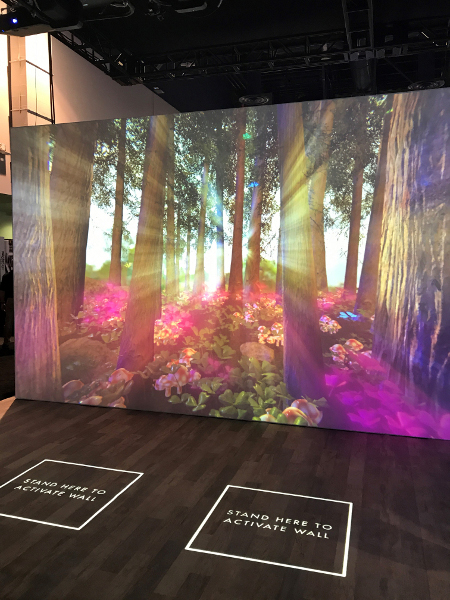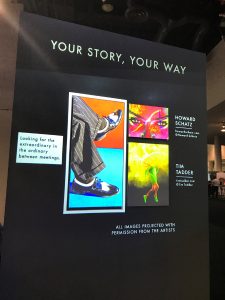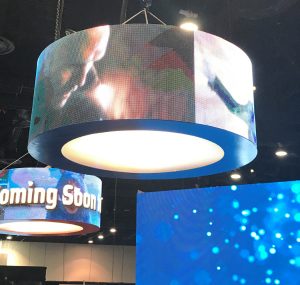The annual Digital Signage Expo (DSE) took place in Las Vegas this past March, showcasing digital products for commercial, retail, healthcare and hospitality, among other applications. In general, I believe DSE is important in bringing new activations to the retail marketplace. And like other events, these digital shows are increasingly a core part of the process of introducing tech-driven experiences to physical stores. Between awards recognizing the retail industry’s use of technology and several standout exhibitors, there are some key features to mention from this year’s show.
THE RED CARPET
Who do you think won this year’s top awards for the use of digital experience in branded environments? The annual APEX Awards were held during DSE – an event that honors companies for innovations, installations of digital displays, interactive technology uses, and most importantly, compelling content. This year, awards were given out in 12 categories from 13 countries.
(The envelope, please!) This year in the “retail environments” category, the top award went to the T-Mobile signature stores. T-Mobile touted its “digital first” philosophy when formulating a design strategy for the six signature stores now open across the U.S. I have to say after visiting the San Francisco store, the brand did a great job. It outpaces the competition with a more thoughtful approach to architectural integration. Other tech/service providers’ interiors can come off as too campy or too thematic, while the T-Mobile stores feel more like a true mobile screen experience.
A runner-up in the same category was retailer Ellynne Bridal for its clever use of so-called “magic mirrors” that have been in our design space for at least five years now. Finally, someone created a great UX outcome for what is arguably a stressful moment for brides to be: finding that perfect dress.
Another winner I have to acknowledge from the “restaurants, bars and foodservice” category is a QSR brand called Pink Fish. Based in Norway, this fast-casual up-and-comer offers top quality salmon in burgers, wraps, salads, hot pots or raw. The brand’s tagline is also a winner: “From Fjord to Fork.”
Advertisement
London-based Portland Design is the creative powerhouse behind Pink Fish, which seems like a new international franchise hit, considering it has now arrived in super-competitive Singapore. The placement of digital elements throughout the space is a prime example of a well thought out customer journey. (I’d encourage our readers to learn more if fast casual is part of your offerings, because this is truly an ideal case study of when and how to use digital.)
THE SHOW FLOOR
There were roughly 200 exhibitors this year at DSE, and just like the APEX award winners, several stood out from among the crowd. In general, the retail offerings seemed to be more plentiful this year, with many suppliers/manufacturers boasting screens or projection activations that were specifically geared to a retail audience.
As for specifics, BrightSign debuted its BSN.cloud service, an important step in the ongoing race to make media player integration easier and more compatible with software platforms. Legacy systems are an issue as brands get stuck with outdated hardware and are hesitant to implement new digital touchpoints because they represent an additional investment. The more we are an “open source” industry, the more we’ll see brands open up to building these touchpoints in store. Another exhibitor, SignageOS, is helping this cause by making it possible for existing CMS software to be compatible with multiple hardware/OS platforms.
Elo showcased its smart screens and software designed to make device management easier as well as push in new applications. This resource remains one of the workhorses of the built environment.
For store designers and visual merchandisers, a variety of manufacturers were showing tie-ins to laser projectors (see Next Store in VMSD’s October 2018 issue) coupled with Avery Dennison’s window films that can go from clear to opaque to create different depths and stacked messaging. For branded graphics ready for digital primetime, this is perhaps one of the most cost-effective ways to bring an eye-catching message to your windows or feature displays.
Advertisement
Samsung showcased its 8K QLED screens which continue to impress when considering sound/visual strategy and content. I think the impact to visual merchandising could be immense. They also continue to talk about the incorporation of an intelligence analytics platform called NexShop. (I like the name!)
These analytics platforms are important – I urge you to pay attention because these sensors that enable real-time data collection are what CEOs are demanding and expecting from digital activations. If you really want to design and create digital experiences, you’d better be thinking about how the store design department is up-selling this aspect. Brands want and need data to justify their efforts these days.
ALL ABOUT THE INVESTMENT
The point is that if you’re designing stores or fast-casual restaurants and other occupied spaces, it’s time to up your game when it comes to specifying and utilizing these systems, or the big agencies will continue to wag our tails. The Next Store is always about great visuals, but also smart solutions that make design teams look good in the C-Suite, too.


 Photo Gallery1 week ago
Photo Gallery1 week ago
 Headlines4 days ago
Headlines4 days ago
 Headlines1 week ago
Headlines1 week ago
 Headlines2 weeks ago
Headlines2 weeks ago
 Headlines1 week ago
Headlines1 week ago
 Designer Dozen1 week ago
Designer Dozen1 week ago
 Headlines1 week ago
Headlines1 week ago
 Headlines1 week ago
Headlines1 week ago


















